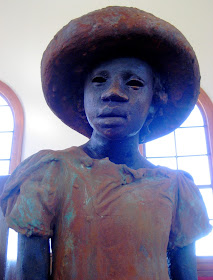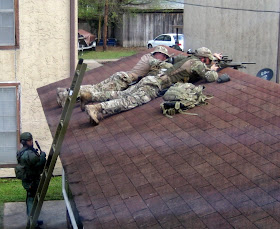When I lived in Alamogordo, I was astonished to discover
the saga of hundreds of chimpanzees (and other primates) there. Really, it's astounding. I invite you to take some time to read it before continuing here. In addition to tragedy, there is heroism, perseverance, and eventually, for some, happy endings.
There are lessons about how expediency and the lack of exit strategies affect ethical decision-making.
 |
| Chimp Haven, Keithville, Louisiana. November 2015. |
In an update story in January 2013, I wrote this:
Today brings important news for the 169 remaining chimps at the Alamogordo Primate Facility on Holloman Air Force Base.
In short --> some? most? all? -- of these chimps will be retired to Chimp Haven in Louisiana.
Here is the final report from the Working Group on the Use of Chimpanzees in NIH-Supported Research.
There is a comment period before their recommendations can be
finalized, but it would seem public opinion is in favor of retiring the
chimps.
What a happy ending to a dismal history. Kudos to Chimp Haven.
When I moved to South Louisiana in November 2013, tucked in one of my brain's dusty corners was that note about Alamogordo chimps going to Louisiana.
But it wasn't until late fall 2015 (!) that I got around to cleaning out that corner, and I realized, damn, I better go take a look at these chimpanzees before I leave Louisiana for good. I discovered that the sanctuary is open to the public only a few times a year, and I'd have to go to the November 2015 open house or I'd miss my chance entirely, as my departure from Louisiana was at the end of February 2016. Spring visit days didn't start til April.
So I did go to Chimp Haven in November, whereupon I got some good news and some, well, not bad news, but personally disappointing news.
 |
| Chimp Haven, Keithville, Louisiana. November 2015. |
The Alamogordo chimps didn't go to Chimp Haven, after all, as planned in 2013. Instead, they went to a sanctuary in Florida. So I didn't get to see any of "my" chimps.
However,
November 2015 and
March 2016 reports, which came out after my visit to Chimp Haven, announced that other chimps from Alamogordo (the Holloman Air Force base), which had been diverted to a San Antonio, Texas, research facility in 2010,
would go - and in fact, have gone - to Chimp Haven.
It's especially nice to hear that this particular contingent was sent to a sanctuary, because while at the San Antonio facility, they were still "on call" for potential research use, whereas the chimps that remained in Alamogordo were retired from research.
 |
| Chimp Haven, Keithville, Louisiana. November 2015. |
So about my trip to Chimp Haven.
Chimp Haven and places like it are the culmination of hope, inspiration,
money, many hard hills climbed and rocky roads trudged,
money,
the skill to execute on visions, and the ability to share a vision with
people who have the wisdom, wealth, networks, and willingness to donate
work necessary to transform the vision into reality. And more
money. Oh yeah, and the ability to receive more rejections than acceptances.
 |
| A human skull and a chimp skull. Chimp Haven, Keithville, Louisiana. November 2015. |
So when I visited Chimp Haven, it was with all this understanding in mind, and the consequent admiration for all that I saw.
It's
a grand space for the chimps. A good amount of room to hang out in,
exercise in, play in. The staff and volunteers cook up ways to keep the
chimps' minds agile and engaged in life.
Polite and careful boundaries and protocols exist between chimps and caretakers.
 |
| Mmmm, salad. Chimp Haven, Keithville, Louisiana. November 2015. |
Even so, a couple of factoids had me mentally tilting my head in askance.
One: For all intents and purposes, what separates the chimps from the humanoids is a watery moat. Staff confidence that this is sufficient to keep chimps from swimming across is based on the "fact" that chimps' bone density is such that it is physically impossible for chimps to swim. They'd sink. Ergo, a moat that is deep enough to require swimming is an impenetrable barrier. This fact is (or at least was in 2012) also accepted by Steve Ross, director of the Lester E. Fisher Center for the Study of Conservation of Apes at Lincoln Park Zoo in Chicago, as cited in
this ABC news story:
Indeed, the same muscles that are considered to be the source of a
chimp's strength can also be seen as a detriment for the animal. The lengthy muscle fibers mean chimps and other great apes can't swim,
Ross said. To protect humans, many zoos create water barriers around the
chimps' area so they cannot physically approach, Ross said.
When I heard the fact about bone density, I had to check it out. And discovered:
Chimpanzees, Orangutans Can Swim and Dive, Biologists Prove (2013)
Two: On birth control. In talking with a staffer or volunteer, I learned there have been some
"whoops" babies (2012) born into the community. [Also one born five years earlier
per this story.]
I got the impression - perhaps mistaken - that Chimp Haven practices pregnancy prevention by way of oral contraception for the female chimps, which is added to their food. I was unclear why the male chimps wouldn't simply be vasectomized.
Well, in writing this post, I discovered that, according to the articles linked above, they are and were. But evidently there is a failure rate. Or perhaps the method used leaves the door open for a natural reversal in some cases. I dunno.
Until Chimp Haven could ensure proper new vasectomies, the female chimps received a regimen of oral contraceptives.
This 2006 article, written by veterinarians, suggests two variables that can affect the efficacy of oral contraception:
1. Need to have a dose strong enough to do the job, but not so strong as to eliminate the appearance of 'cycling' to male chimps
During
peak swelling, females demonstrate more assertive behavior. Troop
males of all ranks interact preferentially with intumescent females and
their offspring. Competition between males, concurrent with agonistic
behaviors, will occur with increased frequency in the presence of
cycling females. It is has been documented that mother-raised infants
benefit from the presence of cycling females in a troop and have
improved adult social and sexual competence.
Because
of the profound effects on the normal sociosexual behavior of
chimpanzees, genital swelling should not be completely eliminated by the
contraceptive option elected. In considering contraceptive options,
both genders must be evaluated to permit prevention of pregnancy while
minimizing impact on troop behavior.
2. Got to watch out for pill-hiding shenanigans and other factors
It is critical
that the female receive [the oral contraception] daily, consistently at the same
time of day, and completely without refusal for optimal pregnancy
prevention. Chimpanzees can be experts at secreting pills offered so
complete consumption must be assured and the training maintained by
utilizing the package placebos. When a pill is missed, a second dose
should be administered promptly and if one day is entirely missed, two
doses should be offered within 24 hours to maintain efficacy. A
side effect of administration of many antibiotics, particularly by the
oral route, is reduced efficacy of oral contraceptives due to changes in
drug metabolism. [Emphasis in the original text.]
So the issue of pregnancy prevention with chimps - not so cut (get it?) and dried as I would have thought.
 |
| Dinner coming. Chimp Haven, Keithville, Louisiana. November 2015. |
Chimp Haven grows at least some of the food on campus.
 |
| Chimp snacks! Chimp Haven, Keithville, Louisiana. November 2015. |
I tasted the crunchy snack in the pic above. Not bad.
 |
| More chimp snacks. Chimp Haven, Keithville, Louisiana. November 2015. |
It felt good to go to Chimp Haven. Closed the circle of the Alamogordo chimp story a little bit.
Related posts:










































